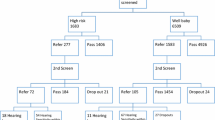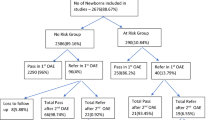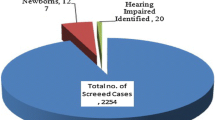Abstract
To identify relation between prevalence of hearing impairment and risk factors at the time of birth in high risk neonates. A year-long study is performed at HBT Medical College and Dr. R. N. Cooper Municipal General Hospital, Vile Parle (west), Mumbai. The Study comprised of 478 high risk babies born between March 2016 and February 2017 and admitted in NICU of the hospital. Out of these 68 babies were either transferred to higher centre or took discharge against medical advice. A total of 410 babies completed the study. Additional 21 eligible babies died in NICU during the study. A Prospective Observational Study is used to analyse the findings of the study. Skew analysis of spread of prevalence across risk factors is used to establish higher prevalence of hearing impairment in high risk neonates. Cramer’s Moment Coefficient of Skewness and Corresponding Test Statistics are used for studying the skewness. Out of 410 babies screened during the study 5 babies were diagnosed with profound SNHL. The risk factors associated with babies is plotted against frequency of babies with Profound SNHL. The plot is found to be un-uniformly distributed and shows inclination towards higher prevalence with high risk babies. Sample skewness (G1) value − 0.81 indicates moderately negative skewed sample. This means the number of babies with profound SNHL found by 3 stage screening is moderately concentrated at high risk weightage.



Similar content being viewed by others
References
WHO global estimates on prevalence of hearing loss, Mortality and Burden of Diseases and Prevention of Blindness and Deafness WHO, 2012
WHO Deafness and hearing loss Fact sheet Updated February 2017
Olusanya B et al (2007) Global burden of childhood hearing impairment and disease control priorities in developing countries. Lancet 369(9569):1314–1317
Jose DJ et al (2016) Prevalence of hearing impairment among high risk neonates—a hospital based screening study. Int J Biomed Adv Res 7(3):131–134
American Speech Language Hearing Association: the prevalence and incidence of hearing loss in children, 2005
Year 2007 Position Statement: Principles and Guidelines for Early Hearing Detection and Intervention Programs; Joint Committee on Infant Hearing, American Speech-Language-Hearing Association
Daniel WW (2012) Biostatistics: a foundation for analysis in the health sciences, 10th edn. Wiley, New York
Author information
Authors and Affiliations
Ethics declarations
Conflict of interest
Authors have no conflict of interest to disclose for the current study.
Human and Animals Rights
Only human were involved in the study.
Informed Consent
Informed consent was taken before doing the study from parents of the neonates.
Additional information
Publisher's Note
Springer Nature remains neutral with regard to jurisdictional claims in published maps and institutional affiliations.
Rights and permissions
About this article
Cite this article
Panjiyar, M.M., Bhargava, S.K., Gite, V. et al. Risk Indicators for Hearing Impairment in Neonates. Indian J Otolaryngol Head Neck Surg 72, 55–58 (2020). https://doi.org/10.1007/s12070-019-01735-6
Received:
Accepted:
Published:
Issue Date:
DOI: https://doi.org/10.1007/s12070-019-01735-6




